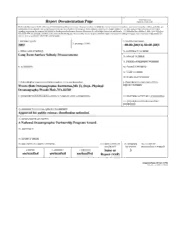Table Of ContentReport Documentation Page Form Approved
OMB No. 0704-0188
Public reporting burden for the collection of information is estimated to average 1 hour per response, including the time for reviewing instructions, searching existing data sources, gathering and
maintaining the data needed, and completing and reviewing the collection of information. Send comments regarding this burden estimate or any other aspect of this collection of information,
including suggestions for reducing this burden, to Washington Headquarters Services, Directorate for Information Operations and Reports, 1215 Jefferson Davis Highway, Suite 1204, Arlington
VA 22202-4302. Respondents should be aware that notwithstanding any other provision of law, no person shall be subject to a penalty for failing to comply with a collection of information if it
does not display a currently valid OMB control number.
1. REPORT DATE 3. DATES COVERED
2003 2. REPORT TYPE 00-00-2003 to 00-00-2003
4. TITLE AND SUBTITLE 5a. CONTRACT NUMBER
Long Term Surface Salinity Measurements
5b. GRANT NUMBER
5c. PROGRAM ELEMENT NUMBER
6. AUTHOR(S) 5d. PROJECT NUMBER
5e. TASK NUMBER
5f. WORK UNIT NUMBER
7. PERFORMING ORGANIZATION NAME(S) AND ADDRESS(ES) 8. PERFORMING ORGANIZATION
Woods Hole Oceanographic Institution,MS 21, Dept. Physical REPORT NUMBER
Oceanography,Woods Hole,MA,02543
9. SPONSORING/MONITORING AGENCY NAME(S) AND ADDRESS(ES) 10. SPONSOR/MONITOR’S ACRONYM(S)
11. SPONSOR/MONITOR’S REPORT
NUMBER(S)
12. DISTRIBUTION/AVAILABILITY STATEMENT
Approved for public release; distribution unlimited
13. SUPPLEMENTARY NOTES
A National Oceanographic Partnership Program Award.
14. ABSTRACT
15. SUBJECT TERMS
16. SECURITY CLASSIFICATION OF: 17. LIMITATION OF 18. NUMBER 19a. NAME OF
ABSTRACT OF PAGES RESPONSIBLE PERSON
a. REPORT b. ABSTRACT c. THIS PAGE Same as 3
unclassified unclassified unclassified Report (SAR)
Standard Form 298 (Rev. 8-98)
Prescribed by ANSI Std Z39-18
Long Term Surface Salinity Measurements
Raymond W. Schmitt
MS 21, Dept. Physical Oceanography
Woods Hole Oceanographic Institution
Woods Hole, MA 02543
Phone: (508) 289-2426 FAX: (508) 457-2181 E-mail: [email protected]
Neil L. Brown
MS 30, Dept. Physical Oceanography
Woods Hole Oceanographic Institution
Woods Hole, MA 02543
Phone: (508) 289-3381 FAX: (508) 457-2165 E-mail: [email protected]
Award Number: NAG5-12444
http://www.whoi.edu
LONG-TERM GOALS
Our long-term goal is to establish a reliable system for monitoring surface salinity around the global
ocean. Salinity has a great influence on air-sea interaction and is believed to have potential for
improving climate forecasts if an observation system can be developed.
OBJECTIVES
This project seeks to develop a new internal field conductivity cell that can be protected from
biological fouling for two years. Combined with a temperature sensor, this foul-proof cell can be
deployed widely on surface drifters. A reliable in-situ network of surface salinity sensors will be an
important adjunct to the planned salinity sensing satellite to be deployed by NASA in a few years.
APPROACH AND WORK PLAN
A new internal-field conductivity cell has been developed by N Brown, along with new electronics.
This sensor system has been combined with a temperature sensor to make a conductivity – temperature
(C/T) sensor suitable for deployment on drifters. The basic sensor concepts have been proven on a
high resolution CTD. A simpler (lower cost) circuit has been designed for this application. A
protection mechanism for the conductivity cell that includes antifouling protection has also been
designed. Mr. A.Walsh of our commercial partner E-Paint has designed time-release formulations of
antifoulants for our application. Mr. G. Williams of partner Clearwater Instrumentation is advising on
power and communication issues for deployment of these sensors on surface drifters. This year we
are running the performance tests on the new sensors.
WORK COMPLETED
The conductivity cell has been constructed in ceramic and has been incorporated into a rotating shutter
mechanism that isolates the cell from biological fouling (Figure 1). The electronic circuitry has been
constructed and extensively tested for stability and noise characteristics. Antifoulants “pads” for this
sensor have been delivered by partner E-Paint, after extensive testing for optimal antifouling
1
performance. Field testing of the completed sensors is about to commence at the WHOI dock, in order
to catch this year’s spring bloom. Different opening/closing/sampling schedules will be tested on the
three units constructed to date.
Figure 1.a, 1.b. The protected cell conductivity-temperature sensor. The left panel shows the open
passage to the conductivity cell; the right panel shows a closed shutter system with the ports for the
antifouling pads in view.
RESULTS
The new rotating shutter mechanism appears to work well, though extensive tests in seawater have yet
to be made. The electronic circuitry has proven to be very stable. This year’s tests will tell us how
long the antifouling formulations can keep the unit free of fouling.
IMPACT AND APPLICATIONS
Economic Development
The development and widespread deployment of a stable salinity sensor for the upper ocean will lead
to an improved understanding of the role of the oceans in the climate system. Theory tells us that this
implies improved predictability of decadal climate change, which would have tremendous societal
benefits.
Quality of Life
Sea surface salinity is a direct indicator of changes in the global water cycle, which is the major
climate change issue of concern to society. It is also a key factor in the potential for abrupt climate
change due to collapse of the thermohaline circulation. A better understanding of climate and
improved climate forecasts would impact farming and fisheries, and greatly improve planning for
water use and energy demand.
2
TRANSITIONS
Economic Development
It is expected that the new sensor, once completed, will be transitioned to a commercial product by
licensing to an appropriate manufacturer.
RELATED PROJECTS
None.
3

